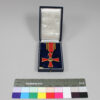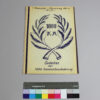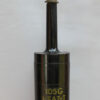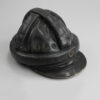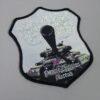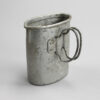Federal Cross of Merit on Ribbon for an explosive ordnance disposal expert
Inventory number: DPM 3.2553.1-2
In 1979, one child died while playing with explosive chemicals and two others were seriously injured. The children found the material on the inadequately secured premises of Chemische Fabrik Stoltzenberg (CFS) in Hamburg. Founded in 1923, the company was actually entrusted with the destruction of chemical weapons from the First World War, many of which came from the poison gas factory on the “Breloh gas site” near Munster, which exploded in 1919. Under the guise of pest control, CFS also supplied the Reichswehr with chemical warfare agents, in violation of the Treaty of Versailles. In addition to the production and development of these substances, the company also exported its knowledge of the construction of poison gas factories abroad in the 1930s and 1940s and experimented with gas protection, such as gas masks. Despite numerous accidents and non-compliance with regulations, the Bundeswehr also cooperated with Stoltzenberg shortly after its establishment, e.g. in the field of respiratory protection or for the supply of fogging agents, but also the chemical warfare agent Lost. The Bundeswehr distanced itself from the company again after repeated unreliability, but the company was not closed down. It was only during the investigation of the accident in 1979 that the desolate condition of CFS and the site became so obvious and public that the site had to be cleared immediately by specialist personnel.
The Hamburg Senate found the right experts for this highly dangerous work in Munster: after the site exploded in 1919, the Wehrmacht set up the explosive ordnance test and training range in Breloh in 1935. To this day, the Bundeswehr’s Explosive Ordnance Disposal unit is still working on finding and recovering unexploded ordnance from test firing during the First and Second World Wars. This work takes a lot of time and will take years to complete, as large areas of the military training area are still contaminated restricted areas.
After the individual identification and delaboration of the often heavily corroded ammunition parts, they are also destroyed in an incineration plant in Munster, formerly the Bundeswehr Science Center, now GEKA.
The team, consisting of civilians and soldiers from the Bundeswehr, was able to use this experience to clear the contaminated factory site. In addition to several dozen tons of toxic substances, which the Bundeswehr was able to remove immediately, the explosive ordnance clearance team found various warfare agents scattered across the entire site, some of which were hidden in hiding places: tabun, lost, phosgene, bromoacetone, chlorine and other substances that were and are used for military poison gas production. The substances were taken to Munster for destruction. Afterwards, however, the site itself had to be cleared: Everything was investigated down to a depth of around three meters in order to find contaminated soil and secret hiding places.
A Bundeswehr explosive ordnance disposal officer recalled: “After about 2 months of cleaning up, [it] was the cleanest site in Hamburg” – he and 41 others were awarded the Federal Cross of Merit by the then Minister of Defense Hans Apel for their efforts. But that was not the end of the story: in 1997 it was discovered that the groundwater was contaminated and a new clean-up was necessary. The site has since been redeveloped.
Object of the month
(short) stories from the depot
Unfortunately, many objects cannot currently be shown in the exhibition for conservation reasons. Here you will find unusual objects and exciting stories of special pieces from the depot



